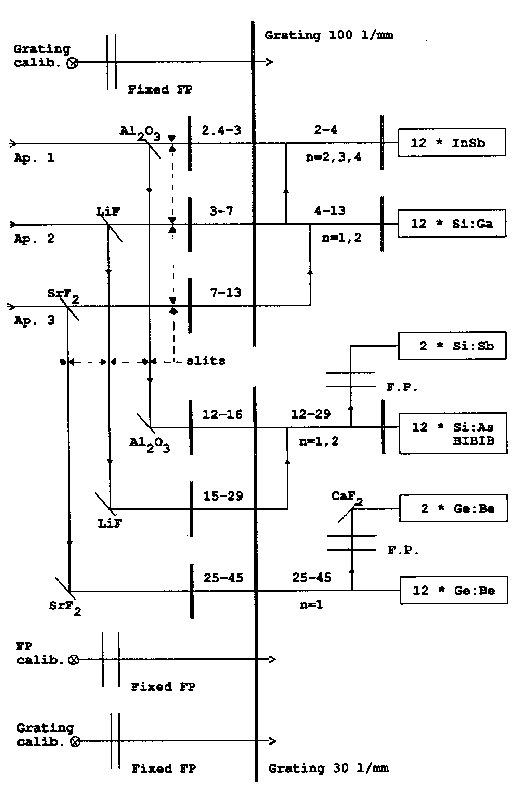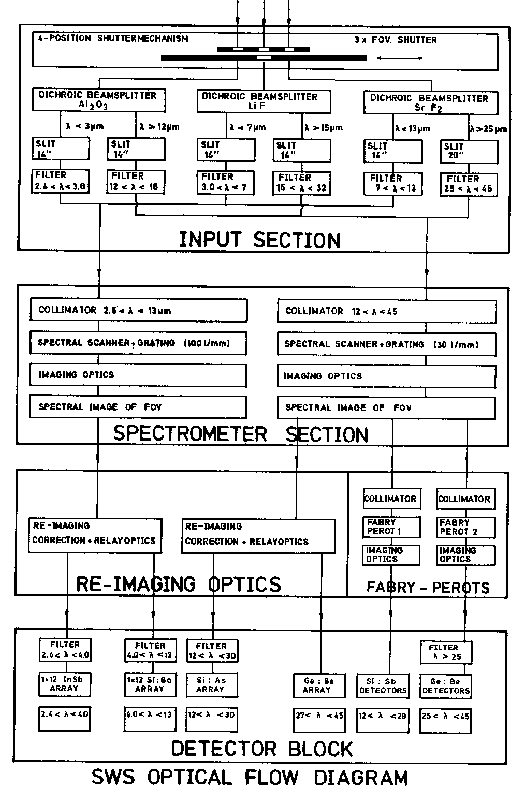




Next: 2.4 Signal Detection
Up: 2. Instrument overview
Previous: 2.2 Instrument Design
2.3 The Wavelength Range Covered
Table 2.1:
Detector definition
for the SWS bands
Sect. |
Band |
Order |
Aper. |
Filter |
Area
|
Detector |
Wavelength |
Resolution |
L |
|
|
|
|
|
|
[
 ] ] |
type |
number |
[ m] m] |
(
 ) ) |
AOT |
|
SW |
1A |
4 |
1 |
 |
14-20 |
InSb
|
1 - 12 |
2.38 - 2.60 |
1870 - 2110 |
756 |
|
SW |
1B |
3 |
1 |
 |
14-20 |
InSb
|
1 - 12 |
2.60 - 3.02 |
1470 - 1750 |
1043 |
|
SW |
1D |
3 |
2 |
 |
14-20 |
InSb
|
1 - 12 |
3.02 - 3.52 |
1750 - 2150 |
1282 |
|
SW |
1E |
2 |
2 |
 |
14-20 |
InSb
|
1 - 12 |
3.52 - 4.08 |
1290 - 1540 |
867 |
|
SW |
2A |
2 |
2 |
 |
14-20 |
Si:Ga
|
13 - 24 |
4.08 - 5.30 |
1540 - 2130 |
2115 |
|
SW |
2B |
1 |
2 |
 |
14-20 |
Si:Ga
|
13 - 24 |
5.30 - 7.00 |
930 - 1250 |
1377 |
|
SW |
2C |
1 |
3 |
 |
14-20 |
Si:Ga
|
13 - 24 |
7.00 - 12.0 |
1250 - 2450 |
4276 |
|
LW |
3A |
2 |
1 |
 |
14-27
|
Si:As |
25 - 36 |
12.0 - 16.5 |
1250 - 1760 |
2047 |
|
LW |
3C |
2 |
2 |
 |
14-27
|
Si:As |
25 - 36 |
16.5 - 19.5 |
1760 - 2380 |
1879 |
|
LW |
3D |
1 |
2 |
 |
14-27
|
Si:As |
25 - 36 |
19.5 - 27.5 |
980 - 1270 |
2524 |
|
LW |
3E |
1 |
3 |
 |
20-27
|
Si:As |
25 - 36 |
27.5 - 29.0 |
1300 |
500 |
|
LW |
4 |
1 |
3 |
 |
20-33
|
Ge:Be |
37 - 48 |
29.0 - 45.2 |
1020 - 1630 |
4324 |
|
LW |
4A |
2 |
1 |
 |
20-33
|
Ge:Be |
37 - 48 |
12.0 - 16.6 |
1250 - 1760 |
2047 |
|
LW |
4C |
2 |
2 |
 |
20-33
|
Ge:Be |
37 - 48 |
16.0 - 19.7 |
1760 - 2380 |
1879 |
|
LW |
4D |
1 |
2 |
 |
20-33
|
Ge:Be |
37 - 48 |
19.6 - 27.6 |
980 - 1270 |
2524 |
|
FP1 |
5A |
3 |
1 |
 |
10-39 |
Si:Sb
|
49 - 50 |
11.4 - 12.2 |
20600 - 24000 |
|
|
FP1 |
5B |
2 |
1 |
 |
10-39 |
Si:Sb
|
49 - 50 |
12.2 - 16.0 |
24000 - 32000 |
|
|
FP1 |
5C |
2 |
2 |
 |
10-39 |
Si:Sb
|
49 - 50 |
16.0 - 19.0 |
32000 - 34500 |
|
|
FP1 |
5D |
1 |
2 |
 |
10-39 |
Si:Sb
|
49 - 50 |
19.0 - 26.0 |
34500 - 35500 |
|
|
FP2 |
6 |
1 |
3 |
 |
17-40 |
Ge:Be
|
51 - 52 |
26.0 - 44.5 |
29000 - 31000 |
|
Notes:
- SW = short-wavelength grating section, LW = long-wavelength
grating section, FP = Fabry-Pérot.
- The SW section is seen in transmission through the filters while
the LW section and the FPs are seen in reflection.
- `Aperture area' refers to the dimensions of the SWS detectors
projected through the entrance apertures projected onto the sky. The
first number refers to the size in the dispersion direction and the
second refers to the cross dispersion direction.
- These are the validated ranges of the bands. The actual
wavelength ranges are slightly greater.
- The resolution given is that obtained when observing an extended
source
 = total number of scanner steps in band.
= total number of scanner steps in band.- Band 2C ends at 13.16
 m for SWS07.
m for SWS07.
- Band 3 uses Back-Illuminated Blocked Impurity Band (BIBIB)
detectors.
- The three extra bands were added as a check to the band 3 data. Data from
them are not produced by the standard OLP pipeline, but can only be generated
using the Observers SWS Interactive Analysis (OSIA).
- Detector 49 is used for FP observations in band
5.
- Detector 51 is used for FP observations in band
6.
- FP2 observations in band 6 are made through the virtual aperture
4 (see Section 3.6) but are flagged in the
data as being through aperture 3.
The design of the SWS instrument subdivides the 2.38-45.2 m
wavelength range into several different bands. There are 12 grating
bands and, for the reduced FP spectral range, 5 FP bands. Sometimes
these bands are also referred to as AOT bands. The
bands, listed in Table 2.1, are combinations of
detector array, aperture and grating orders such that for each band its
detector array sees a unique order of light, and
hence a unique wavelength. Therefore, a request to observe one
wavelength of light defines which array, aperture and grating order to
use. At any given time, the astronomical source of interest to the
observer was centred on one and only one of the three SWS
apertures, feeding light on many, or all, of the 52
detector elements via the two rotatable scanning mirrors. While it was
possible to find scanner settings such that all of the detector arrays
would contain valid data, the instrument was normally operated such that
only one or two of the detector arrays received one order of the
grating spectrometer, the other four or five receiving a mixture of
orders (and hence producing no valid data). However, the observer or
archive user will receive data from all 52 detectors.
m
wavelength range into several different bands. There are 12 grating
bands and, for the reduced FP spectral range, 5 FP bands. Sometimes
these bands are also referred to as AOT bands. The
bands, listed in Table 2.1, are combinations of
detector array, aperture and grating orders such that for each band its
detector array sees a unique order of light, and
hence a unique wavelength. Therefore, a request to observe one
wavelength of light defines which array, aperture and grating order to
use. At any given time, the astronomical source of interest to the
observer was centred on one and only one of the three SWS
apertures, feeding light on many, or all, of the 52
detector elements via the two rotatable scanning mirrors. While it was
possible to find scanner settings such that all of the detector arrays
would contain valid data, the instrument was normally operated such that
only one or two of the detector arrays received one order of the
grating spectrometer, the other four or five receiving a mixture of
orders (and hence producing no valid data). However, the observer or
archive user will receive data from all 52 detectors.
Figure 2.4:
Block diagram of the SWS. The
diagram shows the optical functions of the spectrometer, excluding its internal
calibration sources, but including the shutter, the collimation and the imaging
optics. It excludes band 3E.
|
|
Figure 2.5:
The diagram indicates the
six separate entrance slits
behind the dichroics after the three apertures. It shows all the
spectral order-separation filters and the internal wavelength
calibrators. The shutters, collimation and imaging optics and band 3E have
been left out.
|
|





Next: 2.4 Signal Detection
Up: 2. Instrument overview
Previous: 2.2 Instrument Design
ISO Handbook Volume V (SWS), Version 2.0.1, SAI/2000-008/Dc

